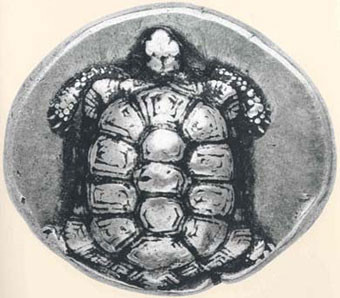
Gepubliceerd op 10th Dec 2010
Gewijzigd op 1st Nov 2023
Oude Griekse munt - Aegina's schildpad

Een van de belangrijkste munten uit de Oudheid was de “Aegina's schildpad”. De munt zelf is niet erg aantrekkelijk als eerste indruk, maar het is een van de belangrijkste munten in de geschiedenis, met eenzelfde impact op het economische leven van de Middellandse Zee als het pond.
Aegina is een eiland in de Egeïsche Zee, in het oosten van Griekenland. Het was een belangrijk handelscentrum in het gebied. Het was de eerste stad in de Griekse geschiedenis die munten sloeg, rond het midden van de zevende eeuw of niet lang daarna.
Toen de behoefte aan munten ontstond, was het belangrijkste aspect het gewicht. Als een munt dezelfde waarde heeft als een andere, moet hij hetzelfde gewicht hebben. De munten werden geslagen in edelmetalen, zoals goud of zilver, en het gewichtsaspect was cruciaal.
Aegina ontwikkelde haar eigen gewichtsstandaard, iets hoger dan de rest van de Griekse wereld. Bijvoorbeeld, een drachme in Athene ("de zolderstandaard") had een gewicht van 4,31 g. en de Aegische drahm had ongeveer 6,3 g. De reden voor deze 45% zwaardere munt was dat deze standaard was afgeleid van de Fenicische, die werd gebruikt door de steden van Fenicië.
Het symbool van deze munt was een schildpad, van bovenaf gezien, met zijn kop omhoog en staart omlaag. Aan de andere kant het symbool als een "quadratum incusum" of incuse vierkant, een typische keerzijde voor de archaïsche periode in het oude Griekenland, gebruikt van de 7e eeuw tot de 5e eeuw.
Gedurende deze tijd hielden "de schildpadden" het gewicht en het metaalgehalte op hetzelfde niveau. Ook werd de munt, vanwege het behoud van de iconografie, bekend bij een toenemend aantal mensen en gebruikt in "internationale transacties".
In 456 v.Chr. werd Aegina lid van de Delos League, een Atheense vorm van controle over de steden die onder haar macht stonden. Bovendien werd in 431 v.Chr., aan het begin van de Peloponesische Oorlog, de bevolking verdreven en vervangen door Atheense kolonisten (klerurchs). Gedurende deze tijd sloeg Aegina geen munten.
Na de val van de Atheense overheersing sloeg Aegina opnieuw munten, vergelijkbaar met de vorige. Alleen op de keerzijde verschenen de letters AIG, in het Grieks, als de eerste 3 letters van de naam van de stad die deze munten sloeg.
Koop nu voor $ 10 korting op de eerste aankoop
Ook werd de zeeschildpad uit de vorige serie vervangen door een landschildpad. De artistieke graad van uitvoering is erg hoog en de munt is erg aantrekkelijk.
Toen de stad haar economische macht verloor, werd de muntslag in de 4e eeuw v.Chr. stopgezet. In de tijd van Alexander produceerden de lokale munthuizen tetradrach van het Alexander-type, met het symbool van de stad, de schildpad en de dolfijn.
Stefan Vasilita.
Zoek de Coin Encyclopedia
Gerelateerde veilingen
gerelateerde artikelen
munten geveild, In navolging van het succesvolle format van zustersites Opal Auctions en Gem Rock Auctions, biedt Coins Auctioned antieke munten, muntcollecties en diverse andere verzamelobjecten aan het publiek aan tegen groothandelsprijzen.
10th Apr 2018
Leer meer over Romeinse munten. Romeinse munt - Het Colosseum Aureus op Coins-Auctioned.com. Het Colosseum Aureus is slechts de tweede van dit soort die bekend is in de wereld. Helpt verzamelaars en handelaren van Romeinse munten van over de hele wereld.
13th Apr 2018
Leer meer over Romeinse munten. Uranius Antoninus 253-254 n.Chr., keizer of niet? op Coins-Auctioned.com. Helpt verzamelaars en handelaren van Romeinse munten van over de hele wereld.
10th Sep 2009
Laatste artikels
Grote centen zijn koperen munten van één cent, geslagen van 1793 tot 1857. Ze behoren tot de eerste officiële Amerikaanse munten. Bekende soorten zijn de krans- en kettingcenten. Leer de soorten, waarden en geschiedenis van grote centen!
11th Jul 2025
Hard Times-tokens zijn onofficiële munten die tijdens de economische depressie van de jaren 1830 door particuliere Amerikaanse bedrijven werden gecreëerd. Ontdek hier de geschiedenis, rebelse ontwerpen en waarde van Hard Times-tokens!
18th Jun 2025
Presidentiële dollars zijn Amerikaanse munten met daarop de namen van voormalige presidenten, uitgegeven tussen 2007 en 2020. Ontdek de achtergrond, details en waardevolle varianten van presidentiële dollars in deze gids.
5th Jun 2025
Artikelcategorieën
Collection of articles providing lots of useful information on coins through the ages.
30 Artikelen





